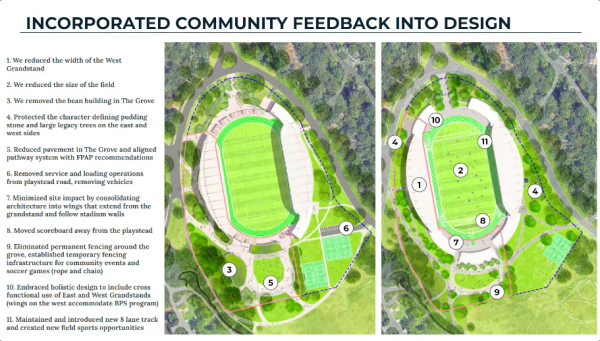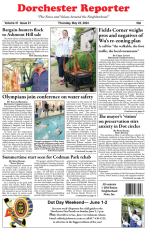May 8, 2024

Rendering courtesy City of Boston
A rendering of the previous White Stadium design (left) as compared to the new design set to be unveiled tonight at a public meeting online. The new design incorporates feedback from the public, including eliminating the “bean building” concession and team store adjacent to the Grove and under the historic Overlook.
City officials and architects involved in the planned renovation of White Stadium last week proposed several significant changes that incorporate suggestions from the public as they work to gather more support for the controversial project that would transform the city-owned facility inside Franklin Park.
The updates – which include changes to the playing field and amenities outside the structure – were first revealed by the Reporter last week before a public meeting last Wednesday (May 8). They will also be discussed at a public meeting set for next Tuesday (May 21) at 5:30 p.m. at the Bolling Building in Roxbury.
One of the most significant changes would eliminate what was known as the “bean building,” a one-story structure that would have been added alongside “the Grove,” an open space at the south end of the stadium and below the park’s historic Overlook section. The building was to serve as a year-round concession area, storage area, and team store for a professional women’s soccer team that will use the facility as part of a deal with the city.
“Doing that allowed us to provide better original views for the Overlook,” said Diana Fernandez, of the Boston Planning and Development Agency’s urban design department. The Overlook, she said, is the only original “key promontory” designed by the park’s creator, Frederick Law Olmsted. The new design allows for more open space with tie-ins to existing pathways and added trees to preserve the Overlook’s natural feel.
In addition, permanent fencing around the Grove has been eliminated to make it feel more open and less exclusive, said Morgan McDaniel, a city official from the mayor’s office acting as the project lead for White Stadium. In some cases, temporary fencing would be put up, but there would no longer be the permanent fencing that was not popular with the public.
Another notable change includes eliminating a service entrance on Playstead Road, which critics said intruded on the natural, tree-lined promenade that is popular with cyclists and pedestrians.
“We heard loud and clear that the service operations on Playstead Road were seen by folks as impeding on the park and instead we’ll maintain that as a pedestrian corridor,” said Fernandez.
Service operations would be moved to the west grandstand on Pierpont Road where soccer gameday shuttles will be arriving and departing.
The wing design, officials said, would minimize impact on the park and consolidate the architecture to make operations fall within the current walls of the stadium. It also allows for reducing the width of the stadium’s West Grandstand to save some legacy sugar maple trees and an outcropping of Puddingstone.
Inside the stadium, the playing field has been reduced in size so that an eight-lane track used by Boston Public School student-athletes would be available at all times and not covered up by seating when not in use.
Officials noted that there would be a tremendous amount of time devoted to BPS athletes and community events, showing timelines that indicated during the soccer season 90 percent of use would be devoted to non-soccer team operations. Boston Unity, the pro team, would practice mid-day on Fridays, and have game-day operations on Saturdays from the afternoon until after 10 p.m.
Outside of the season, they noted, 100 percent of the time would be dedicated to BPS and community uses.
During soccer season (March to November), football would need to be scheduled elsewhere “to maintain the condition of the grass field,” said Dion Irish, the city’s chief of operations. That would call for the Boston Latin School (BLS) and Boston Latin Academy (BLA) football teams to be relocated for much of their seasons.
While there will be the traditional Thanksgiving Day/rivalry games in late November after the soccer season ends, BLS and BLA those teams would need to find new places to practice and play their regular season home games. Irish said that BLS would play and practice football on Clemente Field in The Fens. BLA has yet to secure a location for practice and games.
There are only seven BPS high school football teams still in existence, with many schools no longer able to field a team. For instance, Dorchester’s Jeremiah Burke High School was a state champion and perennial contender in the early 2000s but hasn’t had a football team since before the pandemic. Potentially being able to play one late-season game on White Stadium is seen as “a catalyst” to spark more participation in BPS sports programs, Irish said.
Operations of the Grove area have been a little murky in detail so far, but McDaniel said Boston Unity Soccer would lease the space with the stadium year-round and be responsible for maintaining the concessions across all seasons, staging community programming, and renting out the space to community or regional groups for functions.
One concern raised by critics has been whether the Grove’s popularity with those from outside the neighborhood might push out more adjacent community users.
McDaniel said that “neighborhood vs. region” dynamic is something they are thinking about and have proposed a governance structure to oversee the use of the stadium and the Grove “so the programming reflects what they want to see.”
The lease agreement and accompanying documents that would codify Boston Unity’s use of the stadium and the Grove have not yet been made public. McDaniel said that “the lease is currently a document being negotiated between the city and a private party. We can’t share that right now because of those negotiations. All of the commitments previously stated will be memorialized in the lease and other regulatory documents.”
There will be four documents in all, including a lease document, a cooperation agreement, a memorandum of understanding between Boston Parks and Boston Unity, and the Transportation Action Plan Agreement (TAPA).
“We’re still incorporating feedback from the community into this program,” said Fernandez. “This is work in progress and not a done deal.”
Other proposed design changes include:
•Keeping the basketball courts on the east side of the field but eliminating the tennis courts that are adjacent to the Grove. The courts would be relocated to Scarborough Field, a move that has the support of tennis users and the Franklin Park Coalition.
•Moving the scoreboard away from the Playstead area and incorporating it more into the stadium.
•Removing paving from the Grove area and aligning the pathway system with Franklin Park Action Plan recommendations.
Villages:


